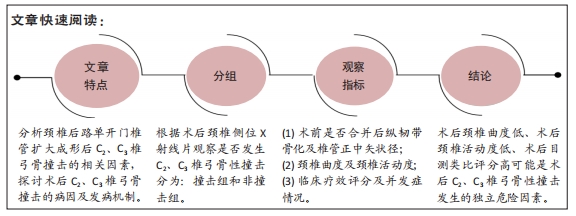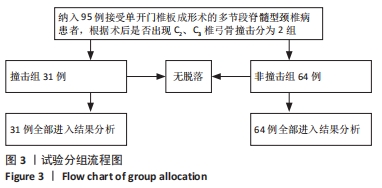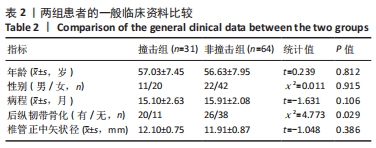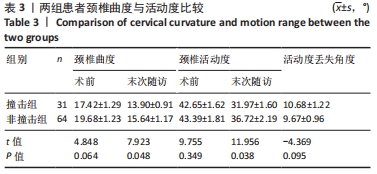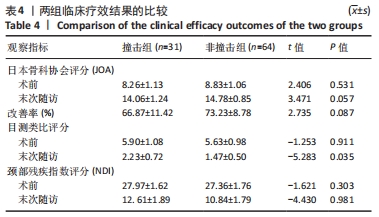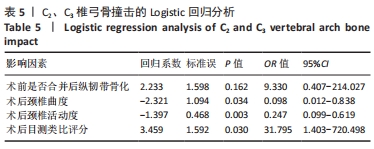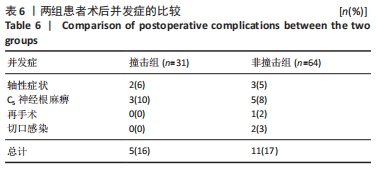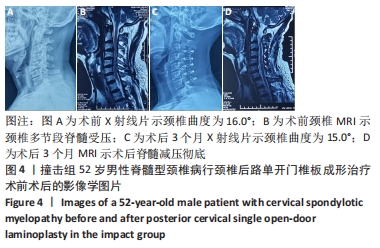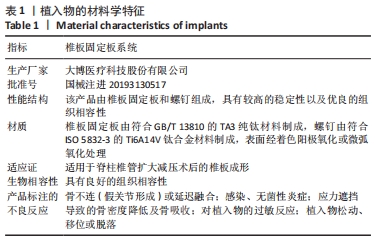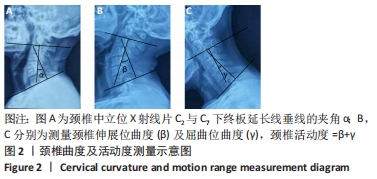[1] DUETZMANN S, COLE T, RATLIFF JK. Cervical laminoplasty developments and trends, 2003-2013: a systematic review. J Neurosurg Spine. 2015; 23:24-34.
[2] 付信杰,孙宇.颈后路单开门椎管扩大椎板成形术术后远期并发症的研究现况[J].中华医学杂志,2020,100(45):3646-3648.
[3] 张为,陈百成,申勇,等.颈3椎板切除单开门成形术对颈椎轴性症状的影响[J].中华骨科杂志,2006,26(8):544-548.
[4] 朱小龙,徐卫星,丁伟国,等.颈椎单开门椎板成形术术后轴性症状的影响因素分析[J].中国骨伤,2018,31(11):1022-1026.
[5] 谢水清,孙天威,田融,等.脊髓型颈椎病单开门椎板成形术后轴性症状的危险因素分析[J].中国修复重建外科杂志,2014,28(5):620-624.
[6] WIGGINS GC, SHAFFREY CI. Dorsal surgery for myelopathy and myeloradiculo pathy. Neurosurgery. 2007;60(1 Supp1 1):S71-81.
[7] 李玉伟,王海蛟,严晓云.改良颈椎管扩大成形术治疗脊髓型颈椎病的远期疗效分析[J].中国脊柱脊髓杂志,2003,13(10):615-616.
[8] SUH BG, AHN MW, KIM HJ, et al. Wedge-Shaped Resection of the Posterior Bony Arch During Open Door Laminoplasty to Prevent Postoperative Motion Limitation. Spine (Phila Pa 1976). 2017;42(3):143-150
[9] YU Z, HE D, XIONG J, et al. Extensor muscle-preserving laminectomy in treating multilevel cervical spondylotic myelopathy compared with laminoplasty. Ann Transl Med. 2019;7(18):472.
[10] HYUN SJ, RHIM SC, ROH SW, et al. The time course of range of motion loss after cervical laminoplasty: a prospective study with minimum two year follow-up. Spine. 2009;34:1134-1139.
[11] LEE GW, SUH BG, YEOM JS, et al. Impact of wedge-shaped resection of the posterior bony arch on postoperative outcomes after open door laminoplasty in the cervical spine: a 2-year follow-up study. Spine J. 2017;17(9):1230-1237.
[12] HELLER JG, EDWARDS CC 2ND, MURAKAMI H, et al. Laminoplasty versus laminectomy and fusion for multilevel cervical myelopathy: an independent matched cohort analysis. Spine (Phila Pa 1976). 2001;26(12):1330-1336.
[13] SATOMI K,NISHU Y,KOHNO T, et al. Long-term follow-up studies of open - door expensive laminoplasty for cervical stenotic myelopathy. Spine. 1994; 19(5):507-510.
[14] 陈维善,陈其昕,王性力.颈椎后路单开门手术对颈椎三维运动及刚性的影响[J].中华骨科杂志,2001,21(4):213-217.
[15] 孙宇,潘胜发,陈景春,等.单开门颈椎管扩大椎板成形术对颈椎运动的影响[J.中国脊柱脊髓杂志,2003,13(4):212-221.
[16] 潘胜发,孙宇,朱振军,等.单开门颈椎管扩大椎板成形术后轴性症状与颈椎稳定性的相关研究[J].中国脊柱脊髓杂志,2003,13(10): 604-607.
[17] WADA E, SUZUKI S, KANAZAWA A, et al. Subtotal Corpectomy Versus Laminoplasty For Multilevel Cervical Spondylotic Myelopathy. Spine. 2001;26(13):1443-1447.
[18] MIYAMOTO S, YONENOBU K, ONO K. Experimental cervical spondyiosis in the mouse. Spine. 1991;16(10):495-500.
[19] KATO M, NAKAMURA H, KONISHI S, et al. Effect of preserving paraspinal muscles on postoperative axial pain in the selective cervical laminoplasty. Spine (Phila Pa 1976). 2008;33(14):E455-459.
[20] WANG SJ, JIANG SD, JIANG LS, et al. Axial pain after posterior cervical spine surgery: a systematic review. Eur Spine J. 2011;20(2):185-194.
[21] YOSHIDA M, TAMAKIT, KAWAKAMI M, et al. Does reconstruction of posterior ligamentous complex with extensor musculature decrease axial symptoms after cervical laminoplasty? Spine (Phila Pa 1976). 2002;27(13):1414-1418.
[22] KAWAGUCHI Y, KANAMORI M, ISHIARA H, et al. Preventive measures for axial symptoms following cervical laminoplasty. J Spinal Disord Tech. 2003;16(6):497-501.
[23] YUSOF MI, HASSAN E, ABDULLAH S. Predicted cervical canal enlargement and effective cord decompression following expansive laminoplasty using cervical magnetic resonance imaging. Surg Radiol Anat. 2011;33(2):109-115.
[24] CHEN H, LIU H, DENG Y, et al. Multivariate Analysis of Factors Associated With Axial Symptoms in Unilateral Expansive Open-Door Cervical Laminoplasty With Miniplate Fixation. Medicine (Baltimore). 2016;95(2):e2292.
[25] 徐勇,李锋,熊伟,等.经肌间隙入路与后正中入路颈椎单开门椎管扩大椎板成形术治疗颈椎后纵韧带骨化症的疗效比较[J].中国脊柱脊髓杂志,2020,30(3):227-233.
[26] YU Z, HE D, XIONG J, et al. Extensor muscle-preserving laminectomy in treating multilevel cervical spondylotic myelopathy compared with laminoplasty. Ann Transl Med. 2019;7(18):472.
[27] CHEN C, YANG C, YANG S, et al. Clinical and Radiographic Outcomes of Modified Unilateral Open-door Laminoplasty with Posterior Muscle-Ligament Complex Preservation for Cervical Spondylotic Myelopathy.Spine (Phila Pa 1976). 2019;44(24):1697-1704.
[28] 徐钦华,王涛,魏凯,等.保留C2棘突止点全椎板减压侧块螺钉固定术治疗累及C2节段的脊髓型颈椎病疗效观察[J].生物骨科材料与临床研究,2018,15(6):45-48.
[29] 张亘瑷,侯宇,陈迎春,等.C3椎板切除并重建C4-7棘突的改良单开门椎板成形术[J].首都医科大学学报,2019,40(4):522-527.
[30] 梁昌详,梁国彦,昌耘冰,等.改良椎板成形术治疗颈椎后纵韧带骨化症术后颈椎矢状位参数变化与临床疗效关系[J].中国脊柱脊髓杂志,2020,30(3):240-247.
[31] CHEN C, LI J, LIAO Z, et al. C3 laminectomy combined with modified unilateral laminoplasty and in situ reconstruction of the midline structures maintained cervical sagittal balance: a retrospective matched-pair case-control study. Spine J. 2020;20(9):1403-1412.
[32] HIRABAYASHI K,WATANABE K,WAKANO K,et al.Expansive open-door laminoplasty for cervical spinal stenotic myelopathy. Spine(phila Pa 1976). 1983;8(7):693-699.
[33] OKADA M, MINAMIDE A, ENDO T, et al. A prospective andomized study of clinical outcomes in patients with cervical compressive myelopathy treated with open-door or French-door laminoplasty. Spine (Phila Pa1976). 2009;34(11):1119-1126.
|
